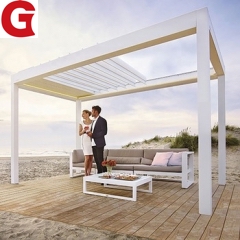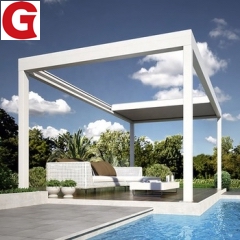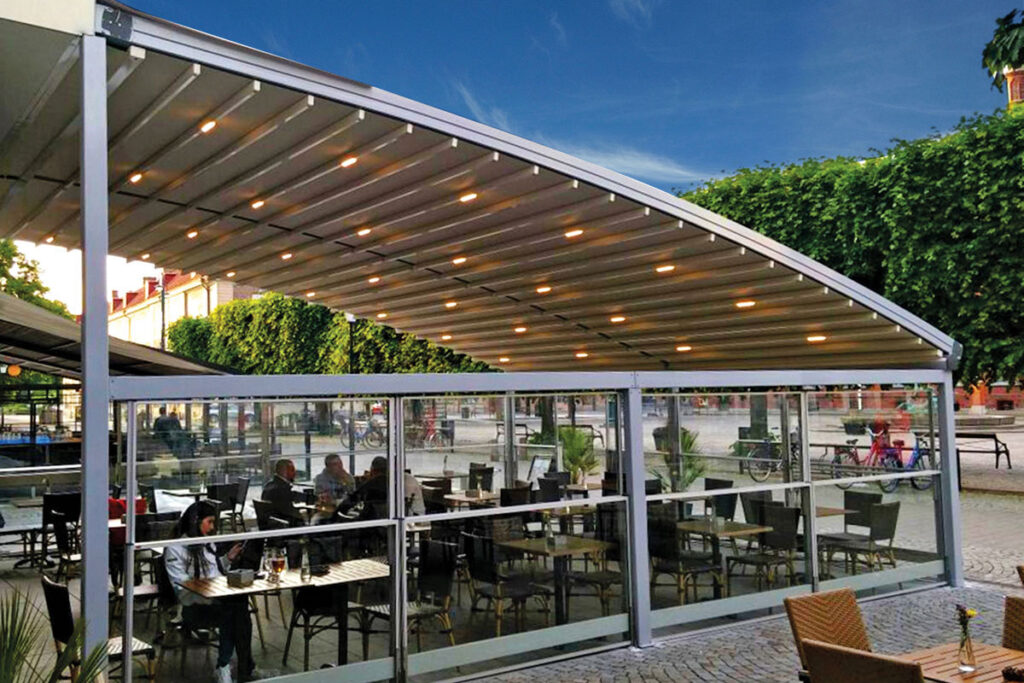Pergolas are an attractive addition to any outdoor space. They provide shade and shelter, and have become increasingly popular in recent years.
There are many roofing options available for pergola designs, each with its own benefits and drawbacks. This article will explore the different types of roofing materials that can be used in a pergola design, as well as important considerations such as climate, budget, maintenance requirements, installation and removal, durability and environmental impact.
By taking these factors into account when selecting a roofing material for your pergola design, you can ensure that you find the perfect option to suit your needs.
Types of Roofing Materials

This section will provide an overview of the different types of roofing materials available to consider when constructing a pergola.
Metal roofs are among the most popular choices as they are durable, lightweight, and fire-resistant. Additionally, metal roofs can offer UV protection from the sun’s rays and good energy efficiency due to their reflective properties.
Wooden shingles or shakes are another option for pergolas with a classic look. These materials can be treated to resist rotting or warping, offering protection against moisture and insects while providing natural insulation.
Plastic polycarbonate panels are becoming increasingly popular for use in pergolas due to their low cost and ease of installation. They also provide excellent UV protection and are highly energy efficient due to their ability to block out heat from the sun while still allowing light in.
Finally, glass panels provide great visibility but come with higher costs than other options. Regardless of which material is chosen, it is important that proper maintenance is done regularly to keep it looking its best for years to come. Considering your desired design requires careful thought since each material comes with its own benefits and drawbacks that should be weighed carefully before making a decision.
Consider Your Design

When considering the design of a pergola, it is important to consider color, style and aesthetics.
Color can be used to complement other elements of the landscape design and create a sense of harmony.
Style is also an important factor in creating a pleasing look for the pergola, as there are many different options available depending on personal preference.
It is also important to keep in mind that the look of the pergola should fit with its surroundings aesthetically so it does not appear out of place or overly conspicuous.
Color
Color is an important factor to consider when selecting materials for a pergola. Open air designs and natural tones are two popular options, as they work together to create a calming atmosphere in the area.
For those who desire something more vibrant, textured finishes like masonry stucco can be used to add some color to the design while still providing a subtle aesthetic.
When it comes to choosing colors for a pergola, style and aesthetics should also be taken into account. From modern metallic accents that reflect light and create an eye-catching look, to rustic wood stains that give off a cozy vibe, there are plenty of options available for homeowners looking to make their outdoor space stand out from the rest.
Style and Aesthetics
By considering various styles and aesthetics, one can create an awe-inspiring pergola that is sure to be the envy of all.
Textures, shapes, and patterns are all elements to consider when designing a pergola roof. Different materials like wood or metal can provide unique textures for the pergola roof while shapes such as arches or domes offer more visual interest. Incorporating patterns into the design with latticework or other designs can add depth to the overall look of the structure.
All these factors should be taken into consideration when selecting a style and aesthetic for your pergola roof. Moving on from there, it’s important to also consider your climate before making a final decision.
Consider Your Climate

Climate is an important factor to take into account when selecting a roof for a pergola. Different climates create different conditions that can affect the performance and longevity of the roofing material.
When considering climate, there are several key factors to consider:
- UV protection: The sun’s ultraviolet (UV) rays can cause certain materials to fade or crack over time, so it is important to choose a roofing material that will provide adequate protection from UV radiation.
- Wind resistance: It is also important to choose a material that won’t be damaged by high winds or strong gusts, as this can result in costly repairs or even replacement down the line.
- Temperature extremes: In very hot climates, it is important make sure that the roof does not absorb too much heat, which could lead to overheating and discomfort under the pergola. In cold climates, choosing a material that offers good insulation can help keep energy costs low during winter months.
- Moisture resistance: Rainfall amounts vary significantly depending on location and season, so it’s important to select a roofing material that won’t succumb easily to water damage or corrosion.
When selecting the perfect roof for your pergola design, taking all these factors into consideration will help ensure you get both functionality and beauty out of your project. With careful attention paid to climate considerations like those mentioned above, you’ll have peace of mind knowing that your pergola will stand up well against whatever Mother Nature throws its way. Budget considerations are also essential when making decisions about your new outdoor living space—but more on this in the next section…
Budget

Cost is an important factor to consider when constructing an outdoor living space, and the adage ‘you get what you pay for’ certainly applies. When it comes to roofing for your pergola design, the more budget-friendly options may seem attractive at first but they may not be cost effective in the long run. Investing in a higher quality material can save money by providing energy efficiency and being more durable. For example, metal roofs are much lighter than traditional asphalt shingles which reduces installation costs as well as energy bills due to their superior insulation properties. Additionally, metal roof systems come with warranties that can provide protection from deterioration over time, making them even more cost effective.
On the other hand, there are some budget-friendly materials such as vinyl or plastic tiles that can still provide some degree of energy efficiency while helping to keep construction costs down. Vinyl tiles come in a variety of colors and textures and offer good durability without breaking the bank. However, these materials may require more frequent maintenance than higher end options like metal roofs or cedar shakes which could potentially increase overall costs in the long run.
When choosing a roof for your pergola design it’s important to weigh all of your options carefully and balance both quality and price. Consider how much you’re willing to spend on materials now versus how much you might need to spend on repairs or replacements in five years’ time before making your final decision.
It’s also important to remember that proper installation is key when it comes to ensuring optimal performance from whatever material you choose so make sure you hire experienced professionals who will do a thorough job regardless of what type of roof system you go with.
No matter which option you ultimately decide upon for your pergola roof, knowing all of its maintenance requirements ahead of time is essential for keeping any unexpected repair costs under control later on down the line.
Maintenance Requirements

Having discussed the importance of staying on budget while choosing a pergola roof, this article now turns to the maintenance requirements associated with various roofing materials. It is important to consider not just initial costs, but also ongoing cleaning and repair frequency and costs. Different materials require different levels of care, so it is essential that homeowners have an understanding of their options before making a choice.
Wood roofs are perhaps the most popular because they can be stained or painted to match any aesthetic preference. However, wood requires regular maintenance such as staining or painting every few years in order to preserve its look and integrity. Additionally, wood roofs may need sanding if they develop splinters over time. On the plus side, wooden roofs tend to be relatively inexpensive when compared with other materials.
Metal roofs offer several advantages over wood including greater durability and less maintenance required over time. Metal does not rust or splinter like wood can, so it tends to require less cleaning than other materials since dirt is easily washed away by rainwater. The downside is that metal can dent more easily than other materials which may require costly repairs should damage occur.
Finally, plastic polycarbonate sheets are lightweight and relatively inexpensive compared with metal or wood; however, these sheets must be cleaned regularly in order for them to remain translucent and avoid discoloration from dust buildup over time. Fortunately they are easy to clean with just soap and water; however, scratches may require replacement if left untreated for too long as damage will limit light transmission through the sheeting material.
Moving forward into installation and removal considerations…
Installation and Removal
Installing and removing a roof for a pergola requires careful consideration of climate, cost, and design in order to ensure the best outcome. It is important to consider the potential environmental conditions that could affect the structure before selecting materials for installation.
Knowledgeable contractors should be consulted when considering installation safety and removal techniques. Properly installed roofs can prevent damage from heavy winds, rain, snow, or hail; however, incorrect installation can cause issues down the line with durability and longevity.
With proper planning and research into building codes and local regulations it is possible to select an appropriate roof that will meet both aesthetic preferences as well as functionality goals while also providing adequate protection against weather-related damage over time.
Transitioning into durability considerations, it is essential to understand how long a particular material may last in order to make an informed decision about which option provides the most value for money spent.
Durability

Having discussed the installation and removal of a roof for a pergola design, it is also important to consider its durability. Durability should be an essential factor in determining the best type of roofing material that will provide long-term protection from the elements.
Weather proofing and UV protection are two key features to look for when selecting a durable roof material for your pergola.
Weather proofing involves protecting against rain, snow, ice, wind damage, hail, and extreme temperatures. The right materials will help you avoid any potential leaks or water damage. A weatherproofed roof will require fewer repairs over time as it lasts longer under harsh weather conditions. On top of this, many weatherproofed roofs come with a warranty that provides extra assurance that you won’t have to worry about replacing them anytime soon.
UV protection is another feature to look out for in order to ensure your roof can withstand the harmful rays of the sun without fading or becoming brittle over time. It is important to select something that will block out at least 98% of UV radiation so that your outdoor area stays protected all year round no matter what kind of climate you live in. Look for materials such as asphalt shingles or metal panels that are designed specifically with UV protection in mind so you don’t have to worry about repairs down the line due to sun damage.
Another factor when selecting your perfect pergola roof is environmental impact: how much energy does it use? What kind of emissions does it release? How much waste does it produce during installation? Answering these questions can help determine which option is most sustainable and eco-friendly while still providing adequate coverage and long-lasting durability.
Environmental Impact

When selecting roofing material for a pergola, it is important to consider the environmental impact of the chosen option. Energy efficiency and sustainability should be prioritized when looking for a material that will not only provide protection from the elements but also help in reducing energy consumption. In addition, materials used should be sourced from renewable resources or recycled products.
There are several options available when considering environmentally friendly roofing materials for your pergola design. The most popular choice is solar panel roofing, which can generate clean energy and reduce carbon emissions. Other eco-friendly options include:
- Recycled metal roofing – made with recycled steel and aluminum, this type of roofing helps reduce landfill waste while still providing excellent durability and performance;
- Living roofs – these are roofs covered with vegetation that offer insulation benefits as well as filtering pollutants from the air;
- Natural slate – natural slate is an excellent choice for its longevity and minimal maintenance requirements; it’s also very durable and has low embodied energy levels.
When selecting a material for your pergola design, it’s important to consider all aspects of environmental impact including energy efficiency, long-term sustainability practices, source of materials used, and potential future costs associated with repair or replacement. By taking into account all these factors you can make sure you select the best option that meets both your aesthetic needs as well as environmental ones.
Frequently Asked Questions
How long does it take to install a pergola roof?
Installing a pergola roof is no small task, but with the right weatherproofing solutions and tips, it can be completed in minimal time.
The process begins by gathering the necessary materials for assembly and securely fastening them to the structure of your pergola.
Once all parts are connected, you will need to adjust the tension of each part for a snug fit and install waterproofing material.
With these steps taken care of, you can finish off with a protective coating that ensures your roof is ready for whatever mother nature throws its way.
For those willing to put in some elbow grease, installing a pergola roof can take just a few hours.
What are the best materials for pergola roofs?
When considering what materials to use for a pergola roof, wooden beams and vinyl fabric are two of the most popular options.
Wooden beams offer a classic look that is sturdy and can be painted or stained to match the existing outdoor decor.
Vinyl fabric is lightweight yet durable, and comes in an array of colors and patterns that can add visual interest to any space.
Both materials have their own unique advantages, so it’s important to consider factors like budget, time frame for installation, desired look, and the amount of sun exposure when making a decision about which material is right for your pergola roof.
How much does a pergola roof cost?
Pergolas are a great way to add aesthetic value to your outdoor living space, but they can come with a hefty price tag. Depending on the type of roof you choose for your pergola and the materials used, installing options can vary from just a few hundred dollars to thousands.
There are many different roof styles that range from traditional flat roofs to much more intricate and expensive designs made with wood or metal panels. No matter which style you choose, it’s important to factor in the cost of installation before making a decision.
With expert craftsmanship and attention to detail, there is sure to be an option that fits both your budget and design preferences.
What is the best way to secure a pergola roof?
The installation of a pergola roof requires careful consideration in order to ensure its long-term stability. Anchors should be securely installed into the ground or wall, depending on where the pergola is located.
Appropriate fasteners should also be chosen for the particular roofing material being used, such as screws or nails that are correctly sized and rated for outdoor use.
Taking the time to properly install anchors and fasteners will help ensure that your pergola roof remains secure for years to come.
Are there regulations or building codes that must be followed when installing a pergola roof?
It is important to know the regulations and building codes that must be followed when installing a pergola roof. Depending on the area, some permits may be required prior to installation.
Furthermore, ordinances may regulate where the roof can be placed or how it must be constructed in order to meet safety requirements. Additionally, certain restrictions may apply depending on the material used for construction and its location relative to other structures.
With this in mind, it is essential to research local laws before beginning any project involving a pergola roof so that all legal guidelines are met.
Conclusion
The type of roofing material is an important decision when it comes to designing a pergola. Research must be done to determine which material will best suit the design, climate, and budget. Maintenance requirements, installation and removal processes, durability, and environmental impact should all be taken into account before selecting a roofing option for the perfect pergola.
When making this important decision, one should consider various options in order to find the most suitable option for their specific needs. Each type of material offers unique benefits that need to be weighed against cost-effectiveness, longevity, maintenance demands and sustainability.
With careful consideration of these factors in mind, one can make an informed decision when finding the perfect roof for their pergola design.

